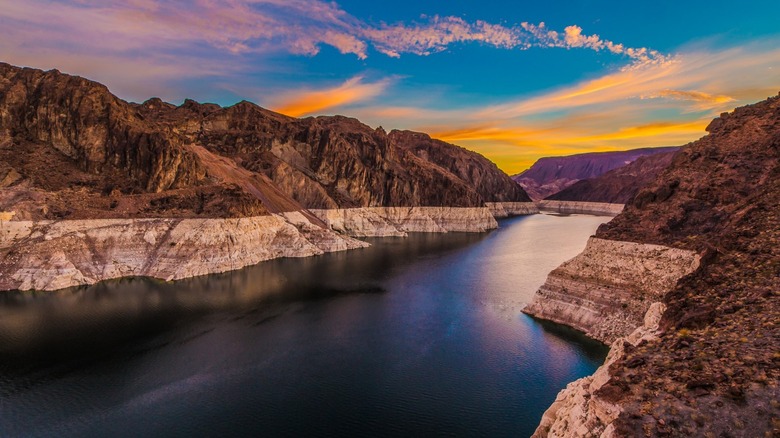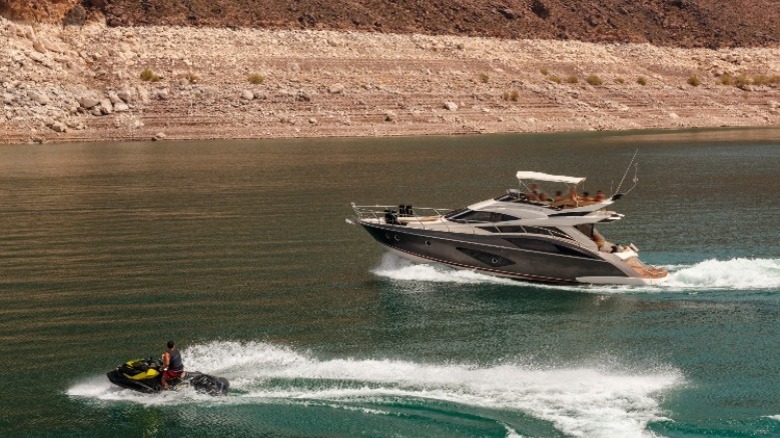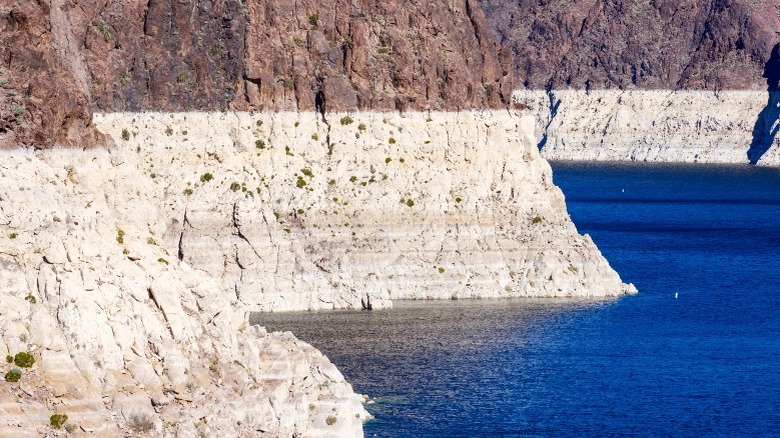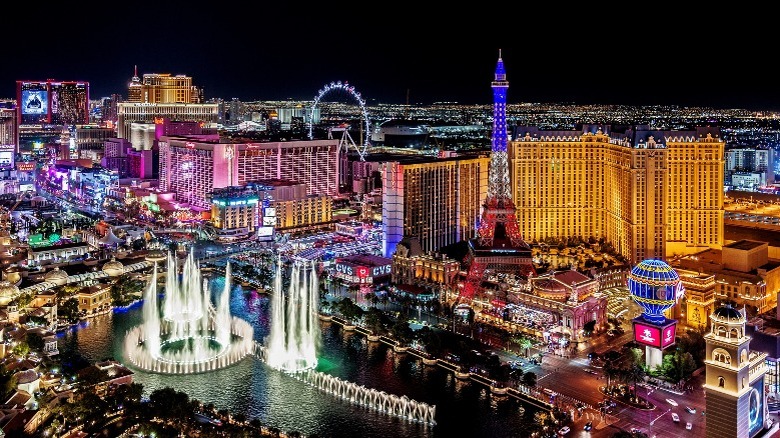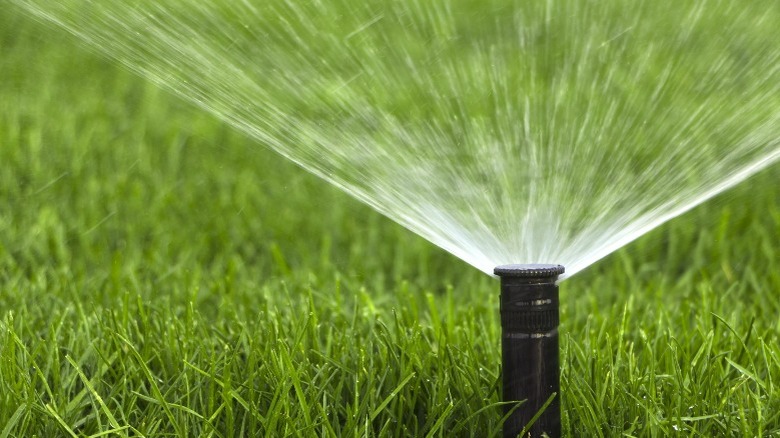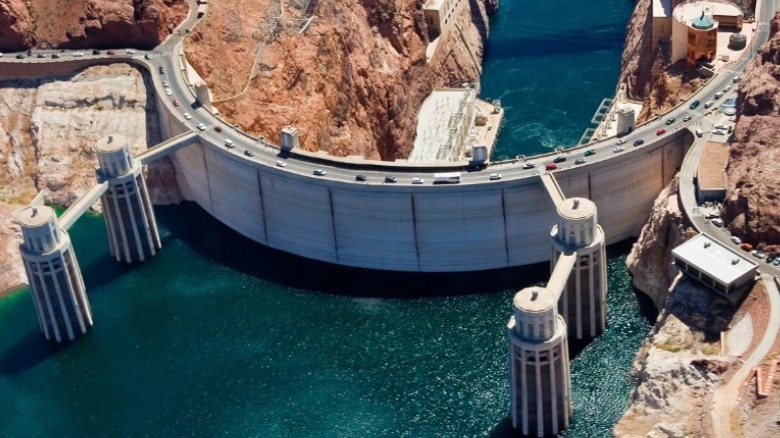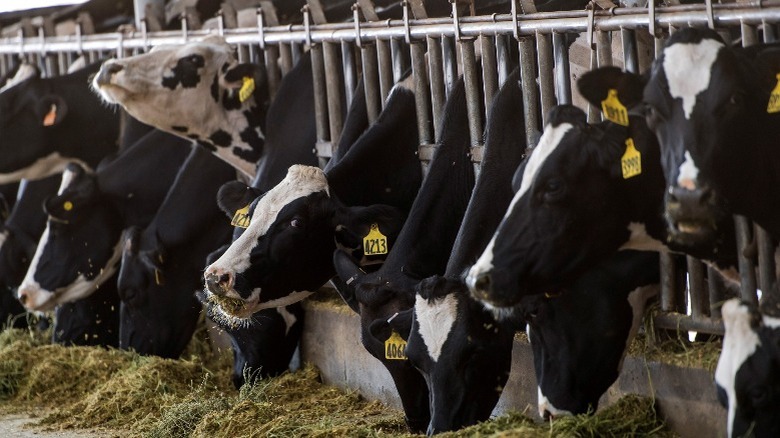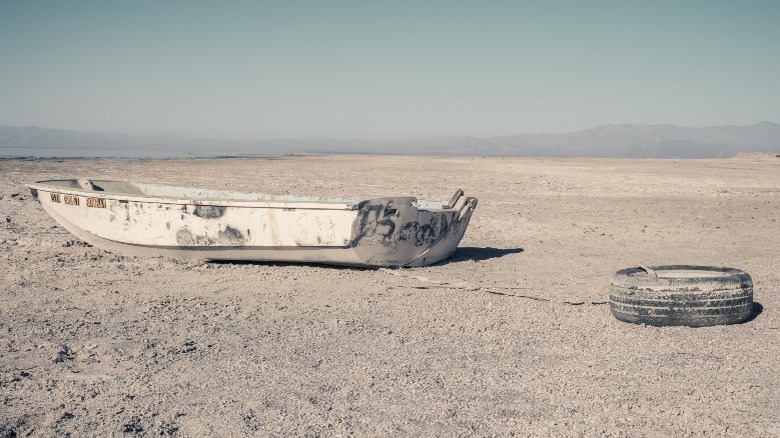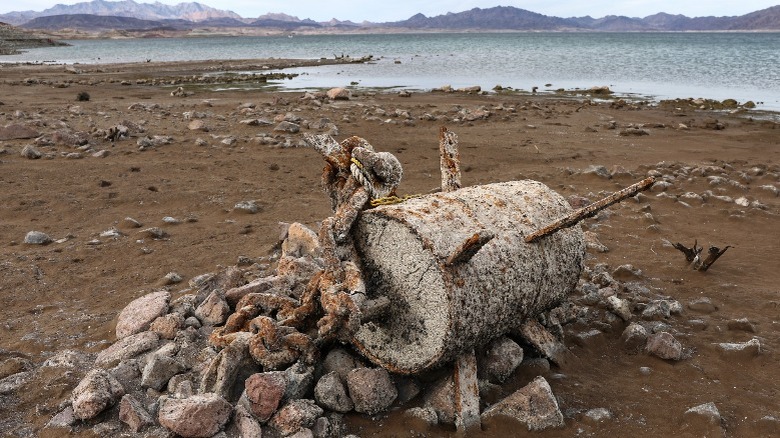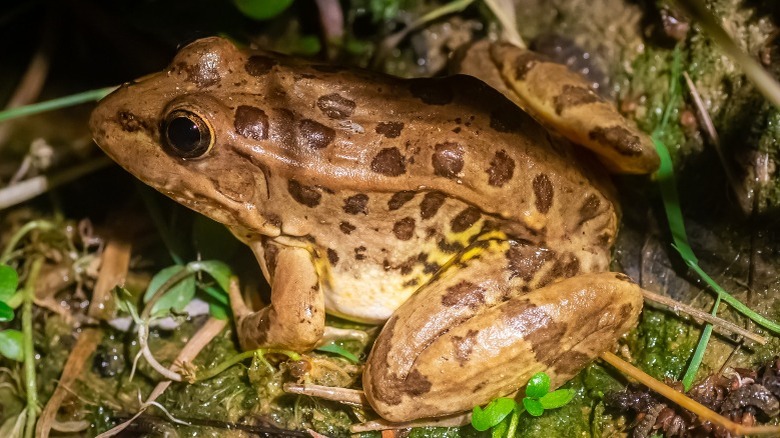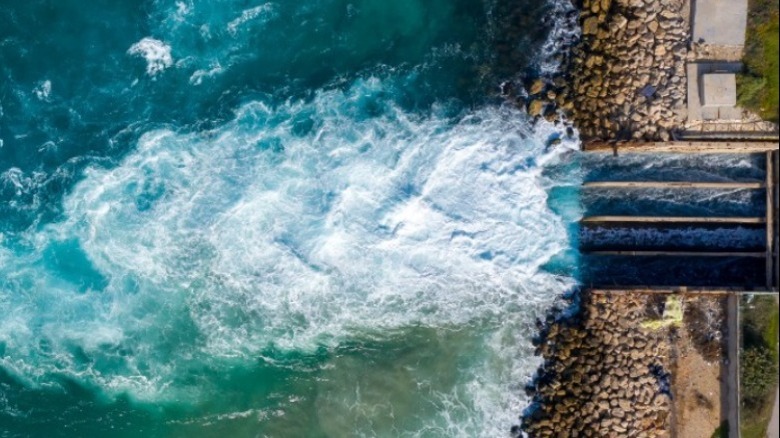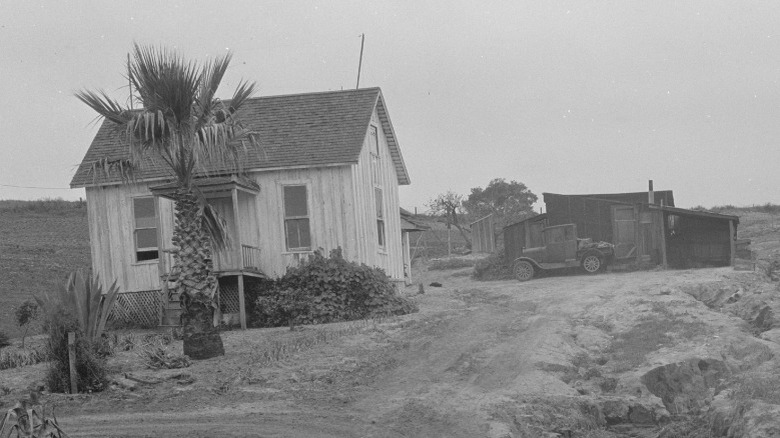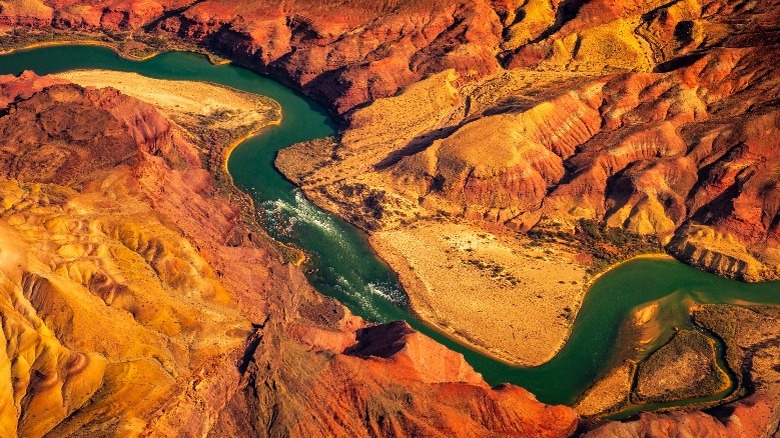What Happens If Lake Mead Dries Up Forever?
Lake Mead was formed following the construction of the Hoover Dam on the Colorado River in 1935. According to the U.S. Bureau of Reclamation — the government agency that manages power and water in the West — it holds more water than any reservoir in the United States. It's also one of the largest manmade lakes in the world (via Britannica). Essentially a flooded canyon, the 229-square-mile lake snakes for 115 miles through the deserts of Arizona and Nevada. It seems vast and never-ending — an inland sea of epic proportions that supplies water and electricity to millions of homes.
But Lake Mead reached its highest volume — 1,226 feet surface elevation and over 28 million acre-feet of water (per the National Park Service) — in the summer of 1983 and has been shrinking ever since. Per Reuters, this historic high point is easily referenced by the white "bathtub ring" of minerals extending up the rock walls bordering the lake, left behind when the water level dropped. According to Reuters, the top of the ring now towers 157 feet above the current surface of the lake. This is equivalent to the Statue of Liberty plus an additional 6 feet.
In 2021, the lake's surface elevation plunged to around 1,067 feet, prompting the Bureau of Reclamation to declare a water shortage for the first time in history (per CNN). Just one year later, in July 2022, Lake Mead's water level fell to around 1,040 feet (per CNN). According to the outlet, it is now at just 27% of its capacity — its lowest volume since it was filled in the 1930s. NASA's satellite imagery shows the once fathomless lake reduced to a fraction of its former glory. With the American West now 22 years into a megadrought, many people are wondering what would happen if Lake Mead dried up completely. Well, it wouldn't be good.
America's first and largest national recreation area would disappear
The Lake Mead National Recreation Area was created by the U.S. Congress in 1964, becoming the first nationally designated area of its kind in the country (per the National Park Service). It is also the largest, occupying 1.5 million acres — an area bigger than the state of Delaware (via Ballotpedia).
Featuring desert wilderness, riparian areas, slot canyons, and two lakes, Lake Mead National Recreation Area is a natural wonderland. According to Travel Awaits, 7.6 million people visited the area in 2021. In fact, it was the fifth most visited national park in the U.S., and Lake Mead is its centerpiece. Surrounded by desert in all directions, the giant lake offers a cool respite from the sweltering heat. Water-related activities like boating, fishing, and swimming are the area's main attractions.
But enjoying water recreation at Lake Mead is already a challenge. According to The Arizona Republic, extending boat launches to keep them open is a constant effort, as most are no longer underwater. Several of its marinas have already relocated to deeper water, and some have closed down permanently. Boaters and swimmers must also be wary of constantly changing terrain as formerly deep areas are now shallow. As the water levels continue to drop, such problems will increase until there is no water left to enjoy at all. And without water, the oasis would evaporate into the surrounding desert like a mirage.
Millions of people would be short on water
According to CNN, the Colorado River system, which includes Lake Mead, supplies water to 40 million people in seven western states. Lake Mead alone brings water to 25 million people living in Nevada, Arizona, California, and parts of Mexico. California has the oldest rights to the lake and therefore gets first dibs (per USA Today). Each year, the Golden State receives the biggest portion of nearly 4.5 million acre-feet, while Arizona gets 2.8 million acre-feet (per the Los Angeles Times), and Nevada gets a mere 300,000 acre-feet (per the National Park Service). To give you an idea of how much water we're talking about, one acre-foot is around 326,000 gallons.
In times of water shortage, the federal government activates a plan in which water use is dialed back in tiers depending on Lake Mead's water levels. In January 2022, with water levels at 1,066 feet, the U.S. Bureau of Reclamation issued its first water shortage declaration, and Tier 1 water cutbacks were put into effect (per CNN). According to Courthouse News Service, Arizona had to reduce its water use by 18%, Nevada by 7%, and Mexico by 5%. Since then, the lake has already fallen below the 1,050-foot cutoff, meaning Tier 2 cuts will be initiated soon, further reducing Arizona and Nevada's allotments.
A Tier 3 shortage, in which lake levels drop to 1,038 feet, is expected to happen by July 2023. At that point, California would begin losing water, too. There is no Tier 4. According to John Entsminger, the general manager of the Southern Nevada Water Authority (via USA Today), "We're 150 feet from 25 million Americans losing access to Colorado River water."
Las Vegas would be left high and dry
No one is more concerned about Lake Mead's plummeting water levels than Sin City. Las Vegas — a sprawling Nevada metropolis with a population of two million people and 40 million tourists a year — relies on Lake Mead for a shocking 90% of its water, per the National Park Service. Historically, water was pulled from the lake and transferred to Las Vegas through a large intake pipe installed in 1971. But, as the lake level dropped, the pipe was rendered inoperable. A new pipe was fitted deeper in the lake in 2000, only to meet the same fate. Desperation led to a more involved solution. In 2015, construction on a 3-mile tunnel 600 feet below the lake's bottom was completed. Called the "third straw," the tunnel allows water to be pulled from the very bottom of the lake (per the National Park Service).
Still, if Lake Mead were to dry up — or just drop to a surface elevation of 895 feet (per 8 News Now) — Las Vegas would be screwed. The city knows this and has taken action. Despite its population growing by 750,000 since 2002 (per CBS News), the city has managed to use 26% less water by eliminating lawns, adhering to watering schedules, and harvesting greywater, which is processed and returned to Lake Mead. Even the famous Bellagio Hotel fountains use a mix of a private well and recycled water. "For having a reputation as a city of excess, we're actually one of the most water-efficient cities in the world," John Entsminger, the general manager of the Southern Nevada Water Authority, told CBS News.
Say goodbye to lawns, swimming pools, and golf courses in the West
Swimming pools and lawns have become a staple of southwestern cities like Phoenix, Los Angeles, and Las Vegas. But this won't be sustainable for much longer. According to the Environmental Protection Agency, as much as 60% of residential water is used outdoors for irrigating lawns, watering gardens, and filling pools. In fact, keeping a thirsty 1,000-square-foot lawn alive can use as much as 330 gallons of water per irrigation session (via Water Footprint Calculator). Meanwhile, the average backyard swimming pool requires around 18,000 gallons of water to fill and can lose thousands of gallons each month to evaporation. Over the course of a year, a single pool can use 30,000 gallons of water. And then there are golf courses, which, in Los Angeles, use 1.6 billion gallons of the city's drinking water each year, as per Club + Resort Business.
Right now, water conservation efforts are left up to the individual in most areas, with a few cities like Mesa, Arizona, offering incentives to replace lawns with native plants. But, if Lake Mead were to dry up, water restrictions would become stricter, and such luxuries could be banned altogether. Already, many southwestern cities — including Las Vegas, Albuquerque, San Diego, Los Angeles, and Tucson — have placed restrictions on outdoor water use, as per a 2010 study published in PNAS.
Many people would be without power
In addition to supplying water to many people in the Southwest, Lake Mead is also a key component of one of the largest hydroelectric power plants in the United States (per World Atlas). According to 8 News Now, Hoover Dam normally supplies electricity to about one million people in Arizona, Nevada, and southern California. Water from Lake Mead must travel through the dam's 17 turbines to produce power, but lately, there has been less water flowing due to the lake's low levels. The dam is already operating at a reduced capacity, producing 33% less electricity (via 8 News Now). According to the outlet, if the lake level drops to 950 feet, the dam's older turbines will begin to struggle. And according to the Las Vegas Sun, if it drops to 895 feet, it reaches a state called "dead pool," where Hoover Dam can no longer produce hydroelectric power or move water downstream.
If Lake Mead reaches "dead pool" and Hoover Dam powers down, Arizona, Nevada, and Los Angeles would be hit the hardest (per The U.S. Bureau of Reclamation). And the negative effects probably wouldn't stop there. According to Circle of Blue, if Glen Canyon Dam — a similarly sized dam on the Colorado River — were to fail, not only would the cost of electricity in impacted areas skyrocket, but the whole power grid could be disrupted, especially if it happened in summer.
Agriculture would tank in the Southwest – and beef would get even more expensive
According to The Guardian, a shocking 75% of the water taken from Lake Mead goes toward irrigating crops like alfalfa and hay, which are used to produce cattle feed. Under Tier 1 restrictions, which primarily impact the agricultural industry, Arizona farmers are already working with 60% less water in the desert, as per Modern Farmer. As a result, up to 40% of Arizona's farmland may lay fallow, meaning the state's main crops — alfalfa, hay, and cotton — are not being produced at the usual rate. The ramifications of this reach further than you might think. Cattle feed prices will increase due to scarcity, which will, in turn, cause the prices of beef and dairy products to increase (per Gizmodo). As The University of Arizona notes, Yuma, Arizona is also the nation's main grower of winter greens like kale, spinach, and romaine lettuce, so you can expect to pay more for those, too.
With Tier 2 and Tier 3 water cutbacks looming on the horizon, interruptions to the nation's food supply will only get worse. Soon, California — which produces two-thirds of the United States' fruits and nuts and one-third of its vegetables (per Gizmodo) — will be impacted. California has already started removing almond trees, which require a lot of water to grow. If Lake Mead's water supply is exhausted, such shortages and high prices will become the norm for everyone in the U.S.
Communities near the lake might have to endure its stinky and toxic demise
As Lake Mead's water level drops, so does its water quality. According to the National Park Service, contaminants from the newly exposed shorelines are reentering warm, shallow areas and becoming more concentrated. And this is just the beginning of what could happen if the lake keeps drying up.
In the desert of California lies another manmade lake condemned to death, the Salton Sea. As CNBC notes, it was once a thriving recreational area in the mid-1900s. But, as the drought took hold, things went horribly wrong. Salt and toxins from years of agricultural runoff began to concentrate in the water as the majority of the lake evaporated, becoming too caustic to support an aquatic ecosystem. Businesses, fish, and birds alike went belly-up. Today, it is a wasteland. Bacteria-produced hydrogen sulfide from the dying lake causes the whole area to reek of rotten eggs, and toxic dust billows from the lake's dry edges, negatively impacting the health of residents in its neighboring communities. As Frank Ruiz, the National Audubon Society's Salton Sea program director, told CNBC, "People here used to fish, swim, bring their boats. They went from living in paradise to living in hell."
According to Richard Thomas in The San Diego Union-Tribune, we can expect to see something similar happen if Lake Mead dries up. Real estate in the lakeside communities of Boulder City, Meadview, and Henderson would likely plummet. Locals who once enjoyed a beautiful lake in their backyard and relied on tourism for income would be faced with a cruel choice: leave or stay in the mess.
A decades-old mob-related homicide (and other crimes) might be solved
So far, two bodies have been exposed by Lake Mead's falling water levels, as per ABC News. In May 2022, a rusty barrel was found stuck in the mud of the lake's receding shoreline. Inside was the body of a man killed by a gunshot wound to the head. Based on the victim's shoes, investigators believe he was most likely killed in the 1970s or 1980s.
With Las Vegas — a city founded by the Mafia — a mere half hour away from Lake Mead, speculation has been rife that it was a mob hit. Geoff Schumacher, the vice president of Las Vegas' The Mob Museum, and Michael Green, a University of Nevada history professor, both compared the body's discovery to the death of Las Vegas mobster John "Handsome Johnny" Roselli, who vanished in 1976 and was later found floating in a steel drum off the coast of Miami. Even Oscar Goodman, the former mayor of Las Vegas who was once a defense attorney for Mafia members, admits that many of his mob clients mentioned wanting to keep the lake levels up and the bodies down — something they referred to as "climate control." "There's no telling what we'll find in Lake Mead," Goodman told ABC News, adding, "It's not a bad place to dump a body."
A lot of other weird stuff would be exposed
As it turns out, there are a lot of strange artifacts lurking at the bottom of Lake Mead. According to the National Marine Sanctuaries, a B-29 Superfortress bomber crashed into the lake while testing new missile tracking technology in 1948. Confounded by its smooth surface, the pilot hit the lake while going about 230 mph. Miraculously, all five crew members survived, but the plane could not be salvaged and still rests at the bottom of the lake.
As the National Park Service notes, the bottom of Lake Mead is also home to a Navy PBY Catalina flying boat (pictured) that wrecked while attempting a water landing in 1949, an aggregate sand and gravel plant used to build Hoover Dam, a 38-foot tow barge from 1946, and Callville, a Mormon settlement turned steamboat port. The entirety of St. Thomas, a former frontier town, used to be under 60 feet of water. But as the water levels receded, the ghost town was resurrected. Per The Guardian, a World War II landing boat also recently reemerged from the depths.
Treasure hunters are flocking to Lake Mead, combing its newly exposed shores for interesting tidbits. According to The Washington Post, everything from guns to designer sunglasses to plastic skeletons has already been discovered as the lake dries. And, as the legend goes, gangster Bugsy Siegel's treasure was dumped in Lake Mead and could turn up any time.
It would push endangered wildlife closer to extinction
The Lake Mead National Recreation Area is home to 387 species of native animals, 10 of which are threatened with extinction, according to the National Park Service. Per the National Audubon Society, it is also designated as an Important Bird Area — 320 different bird species have been documented in Lake Mead and its surrounding environments, including the endangered Southwestern Willow Flycatcher. Waterbirds also rely on the lake, an oasis surrounded by desert, as a stopover during migration.
According to a 2011 study published in Lake and Reservoir Management, the razorback sucker, a critically endangered freshwater fish once common in the Colorado River Basin, has maintained a population in Lake Mead since the 1970s. The changing water levels created nursery areas where young fish could avoid predators, allowing the species to successfully spawn. Damming the Colorado River destroyed most of the sucker's habitat (per the National Park Service), and Lake Mead hosts one of the last breeding populations of the species.
The relict leopard frog (pictured), previously thought to be extinct, only survives in a few springs within the Lake Mead National Recreation Area (per the National Park Service). According to the Center for Biological Diversity, only 500 to 1,100 frogs exist at six locations. Without the lake and its springs, this species would certainly go extinct.
Water would have to come from somewhere else – and it wouldn't be cheap
While the western United States suffers a megadrought, the eastern U.S. is experiencing catastrophic flooding. So, in 2021, political commentator Bill Maher said what everyone was thinking (via Deadline): "Just build pipelines from where the water is to where the water isn't." Unfortunately, it just isn't that simple. According to Joanna Allhands at The Arizona Republic, piping water from East Coast rivers like the Mississippi just isn't viable. For one thing, such solutions would cost billions of dollars. For another, she projects that building such a pipeline would take decades, and we simply don't have that kind of time. In fact, the U.S. Bureau of Reclamation already looked into it and came to the same conclusion.
And then there is the idea of removing salt from ocean water. According to Allhands, a desalination effort in Mexico's Sea of Cortez could add 200,000 acre-feet of water to the West. Similar projects are underway on the California coast — although, according to Pat Mulroy of the Southern Nevada Water Authority (via KNPR), permitting for such projects can take up to 10 years. There's also all that toxic brine to contend with and the negative impact raising the salinity would have on ocean life, as per Environmental Health News. While this solution is a little more viable, it still won't be cheap. Southwest residents can pretty much expect their water bills to keep increasing no matter what.
There would likely be a mass exodus from the Southwest
One way or another, a lack of water in the Southwest would likely prompt people to move. In addition to the possible loss of luxury and jobs, prices for water and power would likely skyrocket. This could be enough to trigger a mass migration out of the Southwest, according to Richard Thomas in The San Diego Union-Tribune. And it wouldn't be the first time in American history that drought caused such an event. In the 1930s, extreme drought caused the Dust Bowl in the Great Plains region, leaving many Americans without water, money, or prospects (per Britannica). According to PBS, 2.5 million people had moved out of the Plains states by 1940. It is currently the largest migration in U.S. history.
Per the World Economic Forum, water shortages and climate change create more refugees than we realize. After all, a person can only live three days without water (per Medical News Today), and they also cannot grow food without it. It's really quite simple: water is essential for life, and when it's in short supply, people will travel to find it.
It would spell doom for the Colorado River
The Colorado River — famous for creating the Grand Canyon, per History — is the lifeblood of Lake Mead, supplying around 98% of its water (per the U.S. Bureau of Reclamation). Starting with snowmelt in the Rocky Mountains and ending in the Gulf of California, the Colorado River has flowed for six million years, as per Smithsonian Magazine. But damming, heavy use, and climate change have taken their toll on the river. According to the National Audubon Society, the river's flow is 20% lower these days, and this trend is likely to continue. If Lake Mead perished, it would be a sure sign that the Colorado River is drying up.
Today, the mighty 3,000-square-mile Colorado River Delta that naturalist Aldo Leopold described in 1922 as being full of emerald green water has been reduced to less than 250 square miles (per Smithsonian Magazine). Lush riparian forests — once home to 400 species of birds and countless other species of plants and animals — have turned to barren mudflats. In fact, the river no longer reaches the sea most of the time. As photographer Peter McBride told Smithsonian Magazine, "It's sad to see the mighty Colorado River come to a dribble and end some 50 miles north of the sea."
